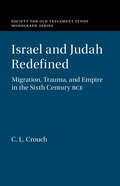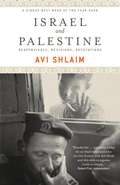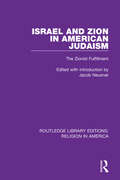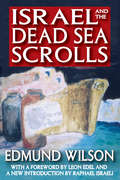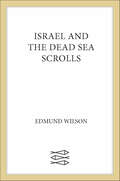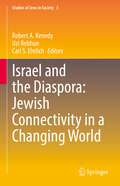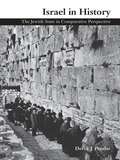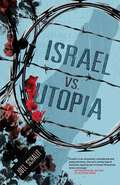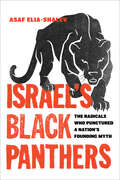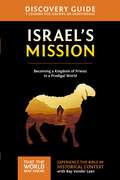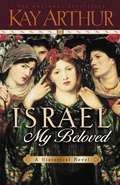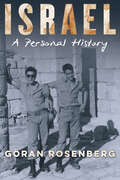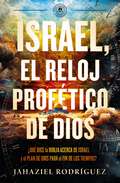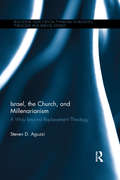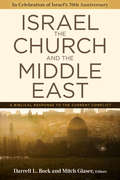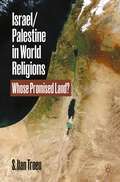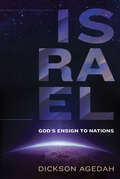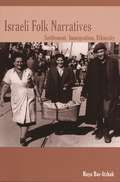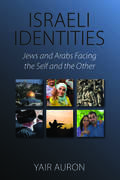- Table View
- List View
Israel and Judah Redefined: Migration, Trauma, and Empire in the Sixth Century BCE (Society for Old Testament Study Monographs)
by C. L. CrouchIn Israel and Judah Redefined, C. L. Crouch uses trauma studies, postcolonial theory, and social-scientific research on migration to analyse the impact of mass displacements and imperial power on Israelite and Judahite identity in the sixth century BCE. Crouch argues that the trauma of deportation affected Israelite identity differently depending on resettlement context. Deportees resettled in rural Babylonia took an isolationist approach to Israelite identity, whereas deportees resettled in urban contexts took a more integrationist approach. Crouch also emphasises the impact of mass displacement on identity concerns in the homeland, demonstrating that displacement and the experience of Babylonian imperial rule together facilitated major developments in Judahite identity. The diverse experiences of this period produced bitter conflict between Israelites and Judahites, as well as diverse attempts to resolve this conflict. Inspired by studies of forced migration and by postcolonial analyses of imperial domination, Crouch's book highlights the crucial contribution of this era to the story of Israel and Judah.
Israel and Palestine: Reappraisals, Revisions, Refutations
by Avi ShlaimWith characteristic rigor and readability, Avi Shlaim reflects on a range of key issues, transformations and personalities in the Israel-Palestine conflict. From the 1917 Balfour Declaration to the 2008 invasion of Gaza, Israel and Palestine places current events in their proper historical perspective, and assesses the impact of key political and intellectual figures, including Yasir Arafat and Ariel Sharon, Edward Said and Benny Morris. It also re-examines the United States' influential role in the conflict, and explores the many missed opportunities for peace and progress. Clear-eyed and meticulous, Israel and Palestine is an essential tool for understanding the fractured history and future prospects of the region.
Israel and Zion in American Judaism: The Zionist Fulfillment
by Jacob NeusnerFirst published in 1993, Israel and Zion in American Judaism: The Zionist Fulfillment is a collection of 24 essays exploring the concept of who or what is "Israel" following the establishment of the Jewish State in 1948 and the subsequent crisis of self-definition in American Jewry.
Israel and its Heirs in Late Antiquity (Elements in Religion in Late Antiquity)
by Andrew TobolowskyThis Element explores constructions of Israelite identity among Jewish, Samaritan Israelites, and Christian authors in Late Antiquity, especially early Late Antiquity. It identifies three major strategies for claiming an Israelite identity between these three groups: a 'biological' strategy, a 'biology plus' strategy, and an 'abiological' strategy, referring to the difference between Jewish claims to Israel premised on exclusive biological descent, Samaritan Israelite acknowledgments of shared descent, and the 'Verus Israel' tradition in Christianity, which disavows the importance of descent. Using this framework, it makes various general conclusions about the construction of ethnic identity itself, including the inadequacy of treating descent claims as the sine qua non of ethnicity and role played in any given vision of ethnic identity by the individual creativity of a given author.
Israel and the Dead Sea Scrolls
by Edmund WilsonThe Dead Sea Scrolls, a collection of 972 documents discovered between 1946 and 1956, are of immeasurable religious and historical significance. They include the oldest known surviving copies of Biblical-era documents. The manuscripts shed considerable light on forms of Judaism never known before. These forms contain hints of Christianity, or as put elsewhere, it was the Judaism amid which Christ and his first followers lived, thought, and wrote. Edmund Wilson's book is a record of this great scholarly find. Wilson was a prolific literary critic and social commentator, not an academic, and therefore Israel and the Dead Sea Scrolls reads like a journalist's reportage. This unique personal account weaves together threads of folklore, history, and intrigue. As Leon Edel writes in his foreword, -Reading him, it is not difficult to imagine the ardor with which Edmund Wilson pursued his complex subject; it was the kind of subject he had always liked best, involving as it did history, politics, ancient lore, and all his faculties for imaginative reconstruction and historical analysis. . . . No book quite like this has been written in our century.- The scrolls of the Essenes, and the history of this Jewish sect's possible antecedence to Christianity, led the author to Israel and to the revelations contained in the scrolls. This book contains his resulting account of the scrolls' history. Originally published in 1978, this edition of Wilson's classic is made contemporary with a new introduction by Raphael Israeli, which illustrates the ongoing academic controversy surrounding the Dead Sea Scrolls.
Israel and the Dead Sea Scrolls
by Edmund WilsonThe author of To the Finland Station and Axel's Castle brilliantly examines the significance of the scrolls' discovery and their role in Jewish history with this insightful biblical study, Israel and the Dead Sea Scrolls “Reading him, it is not difficult to imagine the ardor with which Edmund Wilson pursued his complex subject; it was the kind of subject he had always liked best, involving as it did history, politics, ancient lore, and all his faculties for imaginative reconstruction and historical analysis … No book quite like this has been written in our century.” —Leon Edel, from the introduction.
Israel and the Diaspora: Jewish Connectivity in a Changing World (Studies of Jews in Society #3)
by Uzi Rebhun Robert A. Kenedy Carl S. EhrlichThis collected volume is based on the proceedings of a symposium held in 2018 at York University, Canada, which was held to commemorate the 70th anniversary of Israel. This symposium highlighted contemporary Jewish identity, Israel-Diaspora relations, and how Jewish life has been transformed in light of various types of antisemitism. The book considers the diasporic Jewish experiences through examining the intersections between various Jewish communities sociologically, historically, and geographically.The text covers world Jewry in general, and each of the diaspora and Israeli Jewries more specifically in the context of mutual responsibility, but also focuses on areas of tension concerning values and political matters. The challenges of antisemitism, racism, and nationalism are explored in terms of the relationship of the Jewish diasporas to their host countries. This text also covers antisemitism, which may take the form of traditional antisemitism or of the new antisemitism in the era of anti-Israel activity related to the Boycott, Divestment, and Sanctions movement. The latter movement is especially prevalent on university campuses and has an impact on students, faculty, and staff. This volume is unique in its international perspective in examining issues of Jewish identity, Israel-diaspora relations, and antisemitism and will appeal to students and researchers working in the field.
Israel in Agony
by Zola LevittIn this dramatic story of the agony of Israel, Jewish Christian prophecy analyst, Zola Levitt, takes a penetrating look at the world situation, the Bible, and the Promised Land.
Israel in History: The Jewish State in Comparative Perspective
by Derek PenslarCovering topical issues concerning the nature of the Israeli state, this engaging work presents essays that combine a variety of comparative schemes, both internal to Jewish civilization and extending throughout the world, such as: modern Jewish society, politics and culture historical consciousness in the twentieth century colonialism, anti-colonialism and postcolonial state-building. With its open-ended, comparative approach, Israel in History provides a useful means of correcting the biases found in so much scholarship on Israel, be it sympathetic or hostile. This book will appeal to scholars and students with research interests in many fields, including Israeli Studies, Middle East Studies, and Jewish Studies.
Israel vs. Utopia
by Joel SchalitIsraeli American journalist Schalit distinguishes between the Israel he knows and the image of it in the minds of Americans. Israel is a synonym for many things: the ancestral home of the Jewish people, the hell of the Palestinians; the realization of a centuries-old dream of freedom, and the heart of the War on Terror. No country inspires as much debate about its rights and wrongs, its legitimacy and illegitimacies, than Israel. Historically associated with Europe, such debate finally became common in the U.S. during the Bush era, as America deepened its involvement in the region, and Israel fought three wars. In his new book, Israel vs. Utopia, Israeli American journalist Joel Schalit distinguishes between the Israel he knows, and the image of it that exists in the imagination of Americans. Israel is a state of mind, Schalit argues, as much as it is its own sovereign state. Exploring this tension, in America, in Israel, employing a combination of personal observation, political, and cultural commentary, Schalit defines the instability of Israel, as a metaphor, and America’s troubled love for it, as only an Israeli American would know.
Israel's Black Panthers: The Radicals Who Punctured a Nation's Founding Myth
by Asaf Elia-ShalevThe powerful story of an activist movement that challenged the racial inequities of Israel. Israel's Black Panthers tells the story of the young and impoverished Moroccan Israeli Jews who challenged their country's political status quo and rebelled against the ethnic hierarchy of Israeli life in the 1970s. Inspired by the American group of the same name, the Black Panthers mounted protests and a yearslong political campaign for the rights of Mizrahim, or Jews of Middle Eastern ancestry. They managed to rattle the country's establishment and change the course of Israel's history through the mass mobilization of a Jewish underclass. This book draws on archival documents and interviews with elderly activists to capture the movement's history and reveal little-known stories from within the group. Asaf Elia-Shalev explores the parallels between the Israeli and American Black Panthers, offering a unique perspective on the global struggle against racism and oppression. In twenty short and captivating chapters, Israel's Black Panthers provides a textured and novel account of the movement and reflects on the role that Mizrahim can play in the future of Israel.
Israel's History and the History of Israel: Israel's History And The History Of Israel (Bibleworld Ser.)
by Mario LiveraniIn 'Israel's History and the History of Israel' one of the world's foremost experts on antiquity addresses the birth of Israel and its historic reality. Many stories have been told of the founding of ancient Israel, all rely on the biblical story in its narrative scheme, despite its historic unreliability. Drawing on the literary and archaeological record, this book completely rewrites the history of Israel. The study traces the textual material to the times of its creation, reconstructs the evolution of political and religious ideologies, and firmly inserts the history of Israel into its ancient-oriental context.
Israel's Messiah and the People of God: A Vision for Messianic Jewish Covenant Fidelity
by Jennifer Rosner Mark KinzerIsrael's Messiah and the People of God presents a rich and diverse selection of essays by theologian Mark Kinzer, whose work constitutes a pioneering step in Messianic Jewish theology. Including several pieces never before published, this collection illuminates Kinzer's thought on, topics such as Oral Torah, Jewish prayer, eschatology, soteriology, and Messianic Jewish-Catholic dialogue. This volume offers the reader numerous portals into the vision of Messianic Judaism offered in Kinzer's Postmissionary Messianic Judaism (2005). An introductory essay by editor Jennifer M. Rosner sets Kinzer's thought and writings in context.
Israel's Mission Discovery Guide: A Kingdom of Priests in a Prodigal World (That the World May Know)
by ZondervanJoin renowned teacher and historian Ray Vander Laan as he travels through the land of the Bible. In each lesson, Vander Laan illuminates the historical, geographical, and cultural context of the sacred Scriptures. Filmed on location in Israel, the That the World May Know video series transforms participants’ understanding of God and challenges them to be a true follower of Jesus.The That the World May Know video Bible study series is ideal for use by pastors and small group leaders, as well as anyone interested in deeper, biblical learning.Designed for use with the Israel’s Mission Video Study (sold separately).
Israel's Scriptures in Early Christian Writings: The Use of the Old Testament in the New
by Matthias Henze and David Lincicum, eds.How did New Testament authors use Israel&’s Scriptures? Use, misuse, appropriation, citation, allusion, inspiration—how do we characterize the manifold images, paraphrases, and quotations of the Jewish Scriptures that pervade the New Testament? Over the past few decades, scholars have tackled the question with a variety of methodologies. New Testament authors were part of a broader landscape of Jewish readers interpreting Scripture. Recent studies have sought to understand the various compositional techniques of the early Christians who composed the New Testament in this context and on the authors&’ own terms. In this landmark collection of essays, Matthias Henze and David Lincicum marshal an international group of renowned scholars to analyze the New Testament, text-by-text, aiming to better understand what roles Israel&’s Scriptures play therein. In addition to explicating each book, the essayists also cut across texts to chart the most important central concepts, such as the messiah, covenants, and the end times. Carefully constructed reception history of both testaments rounds out the volume. Comprehensive and foundational, Israel&’s Scriptures in Early Christian Writings will serve as an essential resource for biblical scholars for years to come. Contributors: Garrick V. Allen, Michael Avioz, Martin Bauspiess, Richard J. Bautch, Ian K. Boxall, Marc Zvi Brettler, Jaime Clark-Soles, Michael B. Cover, A. Andrew Das, Susan Docherty, Paul Foster, Jörg Frey, Alexandria Frisch, Edmon L. Gallagher, Gabriella Gelardini, Jennie Grillo, Gerd Häfner, Matthias Henze, J. Thomas Hewitt, Robin M. Jensen, Martin Karrer, Matthias Konradt, Katja Kujanpää, John R. Levison, David Lincicum, Grant Macaskill, Tobias Nicklas, Valérie Nicolet, Karl-Wilhelm Niebuhr, George Parsenios, Benjamin E. Reynolds, Dieter T. Roth, Dietrich Rusam, Jens Schröter, Claudia Setzer, Elizabeth Evans Shively, Michael Karl-Heinz Sommer, Angela Standhartinger, Gert J. Steyn, Todd D. Still, Rodney A. Werline, Benjamin Wold, Archie T. Wright
Israel, Diaspora, and the Routes of National Belonging, Second Edition (Cultural Spaces)
by Jasmin HabibOver the course of four years, Jasmin Habib was a participant observer on tours of Israel organized for diaspora Jews as well as at North American community events focusing on Israel and Israel-diaspora relations. In this book, she argues that much of the existing literature about North American Jews and their relationship to Israel ignores their reactions to official narratives and perpetuates an "official silence" surrounding the destructive aspects of nationalist sentiments. The second edition of Israel, Diaspora, and the Routes of National Belonging includes a new introduction by the author that builds on her groundbreaking research and reflects on the changes to scholarship since the book’s publication in 2004. Additionally, by exploring the dramatic changes to the region’s politics, Habib ensures that the startlingly honest, theoretically rich, and detailed analysis of her original work continues to be of relevance over a decade later.
Israel, My Beloved
by Kay ArthurHistory comes alive as Kay begins with the tragic mistakes that led to Israel's captivity by Babylon and takes readers all the way to the modern-day miracles of triumph against all odds. A heartwarming novel filled with adventure and suspense, Israel, My Beloved is an incredible testimony of God's great love and faithfulness even in Israel's darkest hour.
Israel, a Personal History: A Personal History
by Göran RosenbergCombining poignant memoir and historical research, a son of Holocaust survivors grapples with the dream of Zionism and its consequences.Israel: A Personal History takes off where Göran Rosenberg&’s internationally acclaimed and award-winning childhood memoir, A Brief Stop on the Road from Auschwitz, ends. After his father&’s suicide in 1960 in a small industrial town in Sweden, the remainder of the family, a single mother with two children, emigrates to Israel. At first fully absorbed into the world of pioneer Zionism, enchanted by its visions, formed by its ethos, Rosenberg would eventually embark on a journey of discovery among betrayed ideals, buried stories, false promises, and erased villages.The result is a deeply personal, painstakingly researched, and beautifully written exploration of the contradictory visions that went into the Zionist project, as well as of the ethnic violence, oppression, discrimination, and dispossession caused by its realization. This book is both an exciting history of ideas and the political autobiography of a Jewish European intellectual, a child of dreams and disillusionments, an astute observer of our times.
Israel, el reloj profético de Dios: Qué dice la Biblia acerca de Israel y el plan de Dios para el fin de los tiempos
by Jahaziel Rodríguez¿Qué dice la Biblia sobre Israel y el fin de los tiempos? En Israel, el reloj profético de Dios, el pastor y autor best seller Jahaziel Rodríguez revela la conexión entre la profecía bíblica, el papel central de Israel en el plan de Dios y el inminente regreso de Cristo.A través de las Escrituras y un repaso claro de la historia, este libro explica cómo los acontecimientos pasados y presentes de Israel funcionan como el reloj profético de Dios. Desde los eventos claves de su historia hasta los desafíos actuales y las promesas que todavía esperan cumplirse, Jahaziel guía al lector a comprender por qué Israel es esencial en el plan divino.En estas páginas encontrarás:Las principales profecías sobre el fin de los tiempos y el regreso de Cristo.El papel profético de Israel y su importancia para la humanidad.La relación entre los sucesos históricos de Israel y el cumplimiento bíblico.Promesas futuras que ofrecen esperanza y dirección en tiempos de incertidumbre.Con un estilo claro y bíblico, Israel, el reloj profético de Dios brinda a los creyentes las herramientas necesarias para entender los tiempos actuales, fortalecer la fe y vivir preparados para lo que está por venir.Israel, God&’s Prophetic ClockWhat does the Bible say about Israel and the end times? In Israel, God&’s Prophetic Clock, pastor and best-selling author Jahaziel Rodriguez reveals the powerful connection between biblical prophecy, Israel&’s role in God&’s plan, and the imminent return of Christ.Through Scripture and historical analysis, this book shows how Israel&’s past, present, and future serve as God&’s prophetic clock. From the nation&’s key events to its modern-day challenges and the promises still awaiting fulfillment, Jahaziel explains why Israel is central to God&’s divine plan for humanity.Inside you will discover:The major biblical prophecies about the end times and Christ&’s return.Why Israel is at the heart of God&’s master plan.How Israel&’s history connects directly to prophetic fulfillment.The promises yet to come, bringing hope in uncertain times.Written with clarity and grounded in Scripture, Israel, God&’s Prophetic Clock equips believers to interpret today&’s events, strengthen their faith, and live prepared with hope for Christ&’s return.
Israel, the Church, and Millenarianism: A Way beyond Replacement Theology (Routledge New Critical Thinking in Religion, Theology and Biblical Studies)
by Steven D. AguzziSince the calls of the Second Vatican Council, Roman Catholic theologians have sought to overcome an overarching problem facing Jewish–Christian relations, the concept of "supersessionism"; the idea that God has revoked the spiritual and historical promises made to the Jewish people in favour of granting those same privileges to a predominantly Gentile Church. Israel, the Church, and Millenarianism breaks new ground by applying an ancient principle to the problem of Israel’s "replacement": the early Church’s promotion of millennialism. Utilizing the best in Patristic research, Aguzzi argues that these earliest Christian traditions made room for the future of Israel because Christ’s reign in the Church was viewed as provisional to his historical reign on earth—Israel’s role in salvation history was and is not yet complete. Aguzzi’s research also opens the door for a greater Catholic understanding of the millennial principle, not shying away from its validity and relevance for understanding the importance of safeguarding Jewish particularity, while concluding that the Synagogue and the Church are indeed on a parallel trajectory; "…what will their…[Israel’s]…acceptance be but life from the dead?" (Romans 11:15). Ultimately, the divine will is fulfilled through both Christian and Jewish means, in history, while each community is dependent, in different ways, upon the unfolding of God’s future and the coming Parousia of Christ.
Israel, the Church, and the Middle East: A Biblical Response to the Current Conflict
by Mitch Glaser Darrell BockThe relationship between the church and Israel has been the source of passionate debate among Christians throughout much of church history. In recent years the traditional pro-Israel stance of evangelicals has come under fire by those who support the Palestinian cause, calling for a new perspective and more nuanced approach by Christians who believe that the land of Israel belongs to the Jewish people by virtue of God's covenants and promises.Israel, the Church, and the Middle East challenges the supersessionist drift of the modern church, showing that God retains a plan and purpose for the Jewish people while also addressing a number of the divisive issues raised by authors critical both of Israel and of those who affirm Israel's right to the land. The book explores the hermeneutics and wider effects of the conflict, such as the growing antipathy within the church toward the evangelization of the Jewish people. It provides readers with an objective and interdisciplinary treatment, which is irenic and respectful in tone.The book is directed toward pastors, global Christian leaders, theological students, and well-read lay Christians who are actively seeking guidance and resources regarding the Middle East conflict. The contributors represent a broad evangelical spectrum.
Israel/Palestine in World Religions: Whose Promised Land?
by S. Ilan TroenThe struggle over Israel/Palestine is not just another contest by competing nationalisms or an instance of geopolitical competition. It is also about control of sacred territory that involves local Jews, Muslims, and Christians as well as worldwide faith communities, each with their own interests and stake in what transpires. This balanced introduction to a complex subject presents the multiple positions within the great monotheistic traditions. It demonstrates that the secular discourses in the public square concerning ownership privileges, historical precedence, political rights, and justice that have allegedly replaced religious claims actually coexist with, and often complement, the theological. It explores the century-long tangle of secular and theological debates about Israel’s legitimacy. Whether readers support a Jewish state or are resolutely opposed, the serious and substantial scholarship of this well-reasoned and innovative book will contribute to a nuanced and better-informed understanding of this persistent issue that has entered its second century on the international agenda.
Israel: God's Ensign to Nations
by Dickson AgedahWhy has such a small nation and its people--Israel and the Jews--been the target of so much hatred, for so long? Today's alarming headlines from the Middle East, and tomorrow's trajectory for the region, cannot truly be understood without knowing its complicated history. Israel has been planted as a flag, pointing the world to God. Weaving together biblical and human records, Dickson Agedah brings fresh light on the religious, political, and military roots of the ongoing unrest centered on the land of Jesus' birth. Behind the enmity to the Jewish people and their homeland, he explains, is an all-out spiritual effort to thwart God's plan for the world. A review of Israel’s tortuous and turbulent history reveals and verifies the covenant that God has with His people--an immutable promise extending to all peoples. And while sobering and surprising, this study offers an inspiring message of hope in the sure fulfillment of God's eternal victory and restoration.
Israeli Folk Narratives: Settlement, Immigration, Ethnicity
by Haya Bar-ItzhakThe goals and challenges that face the people of Israel are vividly illustrated by the country's many folk stories. Here Haya Bar-Itzhak presents these tales--gathered from the early settlers of the kibbutz, from immigrants who arrived in Israel after independence, and from ethnic groups--to create a panoramic view of a fascinatingly complex society. Creating stories set in the past, even the recent past, is a way for societies to express their problems, adversities, yearnings, and hopes. Bar-Itzhak finds this true among inhabitants of the kibbutz, who find their society at a crossroads as a result of changes in Israeli society at large. She reveals the symbolic dimensions of their stories--some dealing with the death of young soldiers (sacrificed sons) in battle--as pointing to the complexity of a local culture that expresses the ethos of Labor Zionism. In a section dealing with the folklore of immigrants, Bar-Itzhak focuses on the narratives of Yemenite Jews and Polish Jews. Their stories express their traumatic meeting with Israeli society while providing a means for coming to grips with it. The final section, dealing with ethnic folklore of Moroccan Jews, explores the wonder tale through the perspective of disabled and elderly storytellers, who in the language of their community seek to defend their own values and norms, and examines the saints' legends and the body language usually employed in the telling of them. Throughout, the author illuminates the unique challenge of experiencing ethnicity as Jews vis-à-vis other Jews. Israeli Folk Narratives combines new data with insightful analyses. Anyone interested in folk stories and Israeli culture will be enlightened by this sensitive, thought-provoking book.
Israeli Identities: Jews and Arabs Facing the Self and the Other
by Yair AuronThe question of identity is one of present-day Israel's cardinal and most pressing issues. In a comprehensive examination of the identity issue, this study focuses on attitudes toward the Jewish people in Israel and the Diaspora; the Holocaust and its repercussions on identity; attitudes toward the state of Israel and Zionism; and attitudes toward Jewish religion. <p><p> Israeli Arab students (Israeli Palestinians) and Jewish Israeli students were asked corresponding questions regarding their identity. It was found that, rather than lessening its impact over the years, the Holocaust has become a major factor, at times the paramount factor in Jewish identity. Similarly, among Palestinians the Naqba has become a major factor in Palestinian-Israeli identity. <p> However, the overall results show that the identity of a Jewish citizen of Israel is not purely Israeli, nor is it purely Jewish. It is, to varying degrees, a synthesis of Jewish and Israeli components, depending on the particular sub-groups or sub-identities. The same holds for Israeli-Arabs or Israeli-Palestinians who have neither a purely Israeli identity nor a purely Palestinian (or Arab) one.
